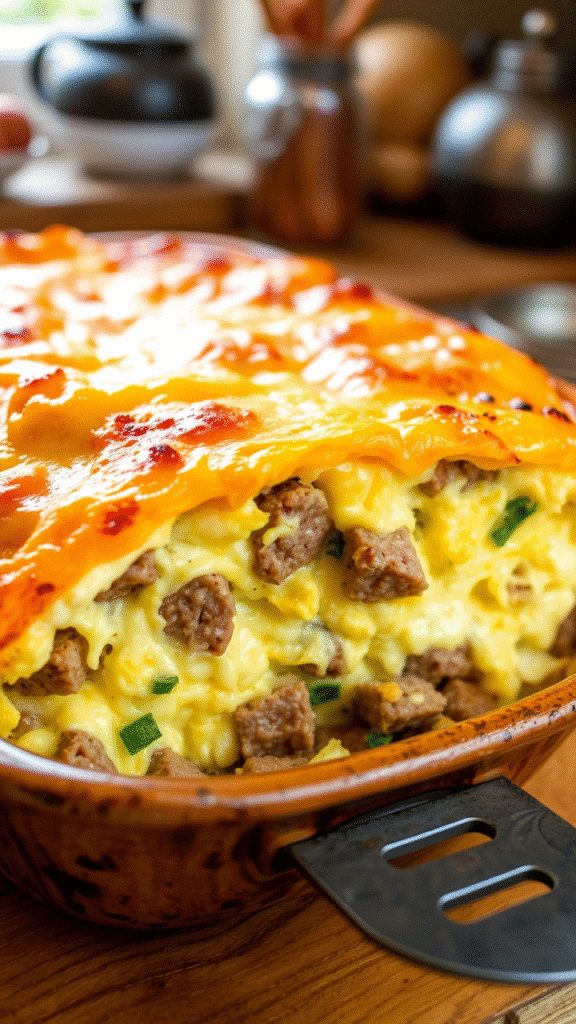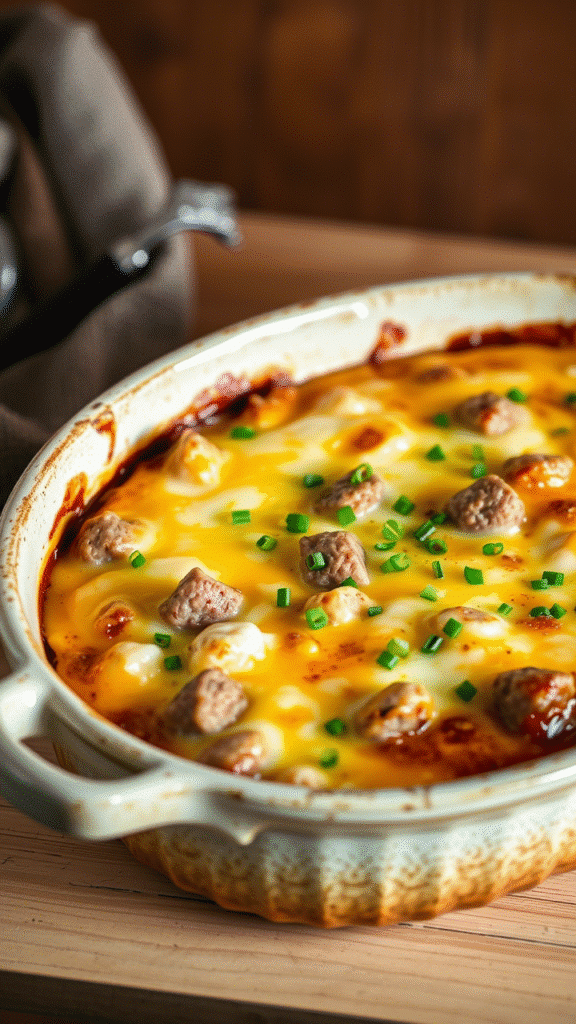The first time I served sausage and egg casserole at my restaurant’s Sunday brunch, I watched a table of six finish three entire portions before their mimosas were half empty. That’s when I knew this wasn’t just another breakfast dish—it was pure comfort food alchemy.
What makes this casserole extraordinary isn’t complexity, but rather the marriage of simple ingredients into something that transforms overnight. The bread soaks up custard-like beaten eggs, the sausage releases its savory fat throughout the mixture, and cheese melts into golden pockets of richness. It’s the kind of dish that makes people lean back in their chairs and ask for your secret.
What Makes This Casserole Special
Unlike rushed morning scrambles, this casserole demands patience—and rewards it generously. The overnight rest allows flavors to meld while the bread transforms from mere filler into a custardy foundation. Professional kitchens love make-ahead dishes because they free up precious morning prep time. Home cooks appreciate how this feeds a crowd without standing over a stovetop flipping individual portions.
The beauty lies in its forgiving nature. Miss the timing by thirty minutes? Still perfect. Forget to add salt to one layer? The sausage compensates. Use day-old bread instead of fresh? Actually better.
This isn’t your typical breakfast casserole that falls apart when served. The structure holds, creating clean slices that photograph beautifully and taste even better.
Ingredients & Substitutions
For the Foundation:
- 1 pound day-old crusty bread, cubed (sourdough or French work exceptionally)
- 1 pound bulk breakfast sausage (Italian or chorizo create interesting variations)
- 8 large eggs, room temperature
- 2½ cups whole milk
- 1 teaspoon dry mustard powder
- ½ teaspoon freshly ground black pepper
- 1 teaspoon kosher salt
For Richness:
- 2 cups sharp cheddar cheese, grated fresh
- ½ cup Gruyère cheese, grated (optional but recommended)
- 4 tablespoons butter, cubed
Aromatics & Vegetables:
- 1 medium yellow onion, diced fine
- 2 bell peppers, any color, diced
- 3 cloves garlic, minced
- ¼ cup fresh chives, chopped
Professional Substitution Notes
Bread choice dramatically impacts texture. Day-old artisanal breads with good crust-to-crumb ratios create the ideal foundation. Avoid pre-sliced sandwich bread—it dissolves into mush. Brioche or challah work beautifully for richer results, though they’ll make the final dish significantly heavier.
Sausage quality matters more than most realize. Cheap breakfast sausage often contains excessive fillers that release strange textures when baked. Italian sausage adds fennel complexity, while chorizo brings smokiness. Turkey sausage works but needs extra seasoning since it lacks the fat content that makes pork versions self-basting.
Cheese should always be grated fresh. Pre-shredded varieties contain anti-caking agents that prevent proper melting. Sharp cheddar provides tang that cuts through the richness, while Gruyère adds nutty depth. Monterey Jack melts beautifully but lacks character.
Room temperature eggs incorporate more smoothly into the custard base. Cold eggs from the refrigerator can create lumpy mixtures that don’t distribute evenly.
For dairy-free versions, unsweetened oat milk works surprisingly well, though you’ll need to add extra seasoning since plant milks lack the natural salinity of dairy.
Step-by-Step Instructions

Preparation Phase
Start by browning the sausage in a large skillet over medium-high heat, breaking it into bite-sized chunks as it cooks. Don’t rush this step—proper browning creates fond that adds depth to the entire dish. Remove sausage and set aside, leaving about two tablespoons of rendered fat in the pan.
Sauté the diced onion in the remaining fat until translucent, about four minutes. Add bell peppers and cook until they’ve lost their raw crispness but still retain some texture. Garlic goes in last, cooking just until fragrant—maybe thirty seconds. Overcooked garlic turns bitter and ruins everything.
Assembly Technique
Butter a 9×13-inch baking dish generously. Layer half the bread cubes evenly across the bottom. Sprinkle the cooked sausage over the bread, then add the sautéed vegetables. Top with half the cheese, then remaining bread cubes. This layering ensures even distribution without creating dense pockets.
Whisk eggs thoroughly in a large bowl until completely uniform. Add milk, mustard powder, salt, and pepper, whisking until the mixture looks like pale yellow silk. Pour this custard slowly over the assembled casserole, making sure it reaches every corner. The bread should look well-soaked but not swimming.
Top with remaining cheese and dot with butter cubes. Cover tightly with plastic wrap and refrigerate overnight. This rest period isn’t optional—it’s where the magic happens.
Baking Process
Remove from refrigerator thirty minutes before baking to take the chill off. Preheat oven to 350°F. Remove plastic wrap and cover with foil for the first half of baking.
Bake covered for 45 minutes, then remove foil and continue baking until the center sets and the top achieves a golden-brown color, about 15-20 minutes more. A knife inserted in the center should come out with just a few moist crumbs.
The surface should puff slightly and feel firm when gently pressed. If the edges brown too quickly, tent with foil while the center finishes cooking.
Common Mistakes and Prevention
Soggy Bottom Syndrome: Use bread that’s at least one day old. Fresh bread absorbs too much liquid and creates mushy layers. Day-old bread maintains structure while still absorbing flavors.
Uneven Cooking: Room temperature ingredients mix more uniformly. Cold eggs create temperature variations that lead to rubbery patches next to undercooked sections.
Bland Results: Season each component separately. Salt the eggs, season the vegetables while cooking, and choose well-seasoned sausage. Building flavor in layers creates complexity that can’t be achieved by adding salt at the end.
Dry Casserole: The milk-to-egg ratio should create a mixture that coats a spoon but isn’t thick. Too many eggs without enough liquid creates a dense, dry result. Too much liquid prevents proper setting.
Cooking Science & Techniques
The overnight rest serves multiple purposes beyond convenience. Bread proteins partially break down in the custard, creating a tender texture similar to bread pudding. Sausage fats distribute throughout the mixture, self-basting during cooking. Cheese proteins begin to soften, ensuring even melting.

Temperature control during baking prevents curdling. Starting covered traps steam that cooks the interior gently, while uncovering allows surface browning through Maillard reactions. The 350°F temperature strikes the balance between thorough cooking and preventing tough, rubbery textures.
The custard base functions similarly to quiche filling. Eggs provide structure through coagulation, while milk adds richness and prevents toughness. Mustard powder acts as an emulsifier, helping fats integrate smoothly.
Serving & Presentation
Cut into generous squares and serve immediately while the cheese still stretches. The contrast between the golden-crisp top and creamy interior creates visual appeal that photographs beautifully.
For brunches, pair with fresh fruit salad and crispy bacon strips. The acidity of citrus cuts through the richness perfectly. Simple arugula dressed with lemon vinaigrette provides peppery contrast.
Coffee service should be strong to complement the rich flavors. Bloody Marys or mimosas work for celebratory occasions, though fresh orange juice offers a lighter alternative.
Professional presentation benefits from individual ramekin portions. Divide the mixture among buttered 6-ounce ramekins for elegant plated service. Reduce baking time to about 25-30 minutes total.
Pairing Suggestions
Beverages: Fresh pressed apple juice enhances the savory elements without competing. Strong coffee or espresso cuts through richness effectively. For alcoholic options, light beers or crisp white wines like Sauvignon Blanc provide acidic contrast.

Complementary Dishes: Roasted asparagus with lemon zest adds color and freshness. Hash browns seem redundant—opt for roasted breakfast potatoes instead. Fresh herb salads with mint and parsley provide palate-cleansing elements.
Seasonal Variations: Spring versions benefit from fresh herbs and asparagus folded into the mixture. Summer adaptations work well with zucchini and fresh basil. Fall versions shine with roasted butternut squash and sage. Winter calls for heartier additions like mushrooms and thyme.
Storage & Reheating
Properly stored casserole keeps refrigerated for up to four days. Individual portions reheat better than large sections—they warm evenly without drying out edges.
For reheating, cover portions with damp paper towels and microwave in 30-second intervals until heated through. Oven reheating at 325°F works for larger portions but takes longer.
Freezing works for up to two months, though texture changes slightly. Thaw completely before reheating, and expect slightly less creamy results.
Creative Variations
Mediterranean Style: Replace breakfast sausage with Italian sausage, add sun-dried tomatoes, spinach, and feta cheese. Use fresh oregano and basil.
Mexican Inspired: Chorizo, diced jalapeños, pepper jack cheese, and fresh cilantro create south-of-the-border flavors. Serve with salsa and avocado slices.
Vegetarian Version: Omit sausage and double the vegetables. Add mushrooms, spinach, and roasted red peppers. Use vegetable broth in place of some milk for depth.
Gourmet Upgrade: Premium ingredients elevate everything. Use artisanal sausage, aged Gruyère, and brioche bread. Add truffle oil sparingly for luxury appeal.
Conclusion
The genius of sausage and egg casserole lies not in complexity but in perfect simplicity executed well. Quality ingredients, proper technique, and patience create results that seem far more sophisticated than the effort required.
Master this foundation and variations become endless. The make-ahead nature makes it invaluable for entertaining, while the comfort-food appeal ensures it’ll become a requested repeat.
Remember that great cooking often means doing simple things exceptionally well. This casserole embodies that philosophy perfectly—transforming everyday ingredients into something memorable through understanding rather than complexity.
Professional kitchens appreciate dishes that scale easily and hold well under heat lamps. Home cooks love recipes that work consistently and feed crowds. This casserole delivers both, making it genuinely useful rather than merely delicious.
Frequently Asked Questions?
Can I make this casserole dairy-free? Yes, substitute unsweetened oat milk or cashew milk for regular milk, and use dairy-free cheese alternatives. The texture will be slightly different but still delicious. Add an extra pinch of salt since plant milks lack the natural sodium content of dairy milk.
How far in advance can I prepare this?
The casserole must rest overnight for proper texture, but you can assemble it up to two days ahead. Cover tightly and keep refrigerated. For best results, don’t add the top layer of cheese until the morning of baking to prevent it from becoming soggy.
What’s the best way to reheat leftovers?
Individual portions reheat most evenly. Cover with a damp paper towel and microwave in 30-second intervals until heated through. For larger portions, cover with foil and reheat in a 325°F oven for about 15-20 minutes.
Can I freeze portions of this casserole?
Yes, properly wrapped portions freeze for up to two months. Cut into serving sizes, wrap individually in plastic wrap, then place in freezer bags. Thaw completely in the refrigerator before reheating. The texture will be slightly less creamy but still very good.
Why did my casserole turn out watery?
This usually happens when vegetables release too much moisture during baking. Make sure to sauté vegetables until most of their moisture evaporates before adding to the casserole. Also, using bread that’s too fresh can create soggy results—day-old bread works best.

Veronica is a passionate food enthusiast with over three years of experience in exploring and writing about diverse cuisines. Her expertise lies in reviewing restaurants, sharing creative recipes, and discovering the latest food trends. As the voice behind FoodieRecap.com, Anju brings fresh perspectives and culinary insights to her audience.
